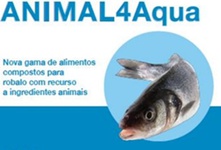
ANIMAL4Aqua
Nova gama de alimentos compostos para robalo com recurso a ingredientes animais
- Responsável Luísa Maria Pinheiro Valente
- Entidade Financiadora Portugal 2020/FEDER/COMPETE 2020
- Referência: POCI-01-0247-FEDER-017610
- Duração 2016-2019
Nova gama de alimentos compostos para robalo com recurso a ingredientes animais
Objectivos e resultados obtidos
A sustentabilidade da aquacultura europeia, a nível económico e ambiental, depende da capacidade da indústria de alimentos compostos em colocar no mercado dietas de elevada qualidade que respondam às exigências dos consumidores, a preços mais competitivos e respeitando o ambiente. Considerando a premente necessidade de encontrar fontes proteicas e lipídicas alternativas às fontes tradicionais, pouco sustentáveis e cada vez mais escassas, para incluir em novos alimentos para robalo, o promotor SORGAL, produtor de alimentos compostos para animais, com dois parceiros envolvidos no tratamento e valorização de subprodutos agroalimentares de origem animal (AVICASAL e SAVINOR), aliou-se a uma unidade de I&D (ICBAS - Universidade do Porto), escolhida pela sua capacidade para desenvolver soluções técnico-científicas. Estas soluções serão internalizadas pelas empresas do consórcio, mas também passíveis de serem externalizadas a outras empresas do setor, através de uma ampla divulgação dos resultados obtidos.
Este consórcio, que constitui o projeto ANIMAL4Aqua, procura estabelecer sinergias com o objetivo de promover e dinamizar a inovação nas empresas através de:
1. Identificação e valorização de ingredientes terrestres de origem animal, produzidos localmente, em dietas para robalo, uma espécie de elevado valor comercial. Serão testados ingredientes resultantes do processamento de subprodutos agroalimentares de origem animal e da produção de insetos, como substitutos de farinha e óleo de peixe em dietas para robalo, bem como o impacto económico e ecológico associado ao uso dos vários ingredientes;
2. Desenvolvimento de uma nova gama de alimentos compostos mais sustentáveis e específicos para robalo, com melhor performance e preços mais competitivos – a incorporação dos melhores resultados permitirá elaborar uma nova gama de alimentos compostos de elevada performance para robalo, permitindo aumentar a performance zootécnica desta espécie e garantindo as características nutricionais e organoléticas do produto final para o consumidor.
Artigos Científicos
Basto, A, Calduch, J, Oliveira, B, Petit, L, Sá T, Maia, MRG, Cabral-Fonseca, S, Matos, E, Pérez-Sánchez, J, Valente, LMP. 2021. The use of defatted Tenebrio molitor larvae meal as a main protein source is supported in European sea bass (Dicentrarchus labrax) by data on growth performance, lipid metabolism and flesh quality. Frontiers In Physiology 12: 659567. https://doi.org/10.3389/fphys.2021.659567
Basto, A, Matos, E, Valente, LMP. 2020. Nutritional value of different insect larvae meals as protein sources for European sea bass (Dicentrarchus labrax) juveniles. Aquaculture 521: 735085. https://doi.org/10.1016/j.aquaculture.2020.735085
Campos, I, Matos, E, Aragão, C, Pintadom, M, Valente, LMP. 2017. Apparent digestibility coefficients of processed agro-food byproducts in European seabass (Dicentrarchus labrax) juveniles. Aquacult Nutr. 2018; 24: 1274–1286. https://doi.org/10.1111/anu.12665
Campos, I, Matos, E, Maia, MRG, Marques, A, Valente, LMP. 2019. Partial and total replacement of fish oil by poultry fat in diets for European seabass (Dicentrarchus labrax) juveniles: Effects on nutrient utilization, growth performance, tissue composition and lipid metabolism. Aquaculture 502: 107-120. https://dx.doi.org/10.1016/j.aquaculture.2018.12.004
Campos, I, Matos, E, Marques, A, Valente, LMP. 2017. Hydrolyzed feather meal as a partial fishmeal replacement in diets for European seabass (Dicentrarchus labrax) juveniles. Aquaculture 476: 152-159. https://doi.org/10.1016/j.aquaculture.2017.04.024
Campos, I, Matos, E, Valente, LMP. 2019. Ability of European seabass (Dicentrarchus labrax) to digest rendered animal fats from fish, poultry and mammals. Aquaculture Nutrition 25(3): 729-736. https://doi.org/10.1111/anu.12902
Campos, I, Valente, LMP, Matos, E, Marques, P, Freire, F. 2020. Life-cycle assessment of animal feed ingredients: Poultry fat, poultry by-product meal and hydrolyzed feather meal. Journal of Cleaner Production 252: 119845. https://doi.org/10.1016/j.jclepro.2019.119845
Monteiro, M, Matos, E, Ramos, R, Campos, I, Valente, LMP. 2018. A blend of land animal fats can replace up to 75% fish oil without affecting growth and nutrient utilization of European seabass. Aquaculture 487: 22-31. https://dx.doi.org/10.1016/j.aquaculture.2017.12.043
Links relacionados:
- https://www.mispeces.com/noticias/f8d807ad-afa2-11e8-aa38-7dee8bdf03d2/#.Xv3EOChKiMo
- https://www.mispeces.com/noticias/Estudios-de-Aquasoja-muestran-el-potencial-de-la-harina-de-insectos-como-nuevo-ingrediente-para-la-alimentacion-de-la-lubina-europea/#.Xv3EPShKiMo
- http://sojadeportugal.pt/pt/sobre/animal4aqua_1034//
